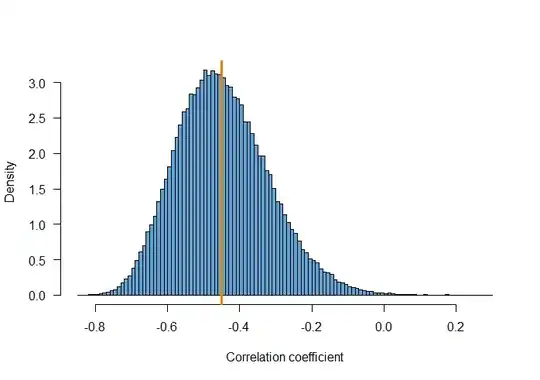First, sample 40 values from a bivariate normal distribution $(X_1, X_2)^T\sim \mathcal{N}(\mathbf{\mu}, \Sigma)$ with a mean vector of $\mathbf{\mu} = (0, 0)^T$ and covariance matrix $$
\Sigma =
\begin{pmatrix}
1 & \rho\sqrt{\frac{\pi}{3}} \\
\rho\sqrt{\frac{\pi}{3}} & 1
\end{pmatrix}
$$
where $\rho$ is the desired correlation coefficient between the standard normal and the uniform $\mathrm{U}(0, 2)$ distribution.
Secondly, apply the transformation $Y_1 =\Phi(X_1)$ in order to transform $X_1
$ to a uniform $Y_1\sim \mathrm{U}(0,1)$ distribution. $\Phi$ denotes the CDF of the standard normal distribution.
Multiply $Y_1$ with 2 (i.e. $Z_1=2Y_1$) to get a uniform $Z_1\sim \mathrm{U}(0,2)$ distributed random variable. The variance of $Z_1$ is $\frac{1}{12}(b-a)^2=\frac{1}{12}(2-0)^2=\frac{1}{3}$.
The covariance between $Y_1$ and $X_2$ is $\frac{\rho}{2\sqrt{3}}$. Because $\mathrm{Cov}(aX, Y) = a\mathrm{Cov}(X,Y)$, the covariance between $Z_1$ and $X_2$ is $2\frac{\rho}{2\sqrt{3}}=\frac{\rho}{\sqrt{3}}$. Hence, the correlation between $Z_1$ and $X_2$ is
$$
\mathrm{Corr}(Z_1,X_2)=\frac{\frac{\rho}{\sqrt{3}}}{\sqrt{\frac{1}{3}}\cdot 1} = \rho
$$
In R:
library(MASS)
set.seed(142857)
n <- 40
rho <- -0.45 # setting the correlation
sigma <- matrix(c(1, rho*sqrt(pi/3), rho*sqrt(pi/3), 1), 2, 2, byrow = TRUE)
x <- mvrnorm(n, mu = c(0, 0), Sigma = sigma)
z1 <- 2*pnorm(x[, 1])
x2 <- x[, 2]
cor(z1, x2)
[1] -0.4343862
I've simulated $10^5$ repetitions of the above process. The distribution of correlation coefficients between $Z_1$ and $X_2$ is shown here (the vertical orange line denotes the correlation coefficient of $\rho = -0.45$).

